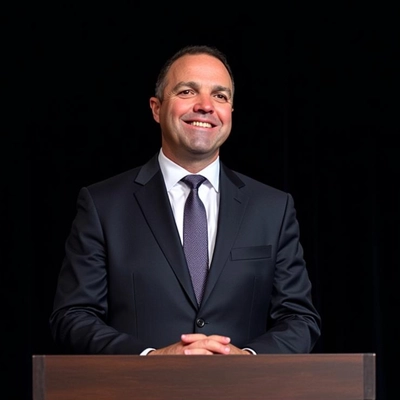17 Strategies for Using Ugc During the Customer Journey
User-generated content (UGC) has become a powerful tool in modern marketing strategies. This article explores effective ways to leverage UGC throughout the customer journey, drawing insights from industry experts. Discover how authentic user stories, micro-influencer strategies, and customer success narratives can significantly enhance your brand's credibility and engagement.
- Repurpose UGC Across Entire Customer Journey
- Build Trust with Authentic User Stories
- Leverage Short-Form UGC Origin Stories
- Showcase Real Customer Journeys and Doubts
- Use Informal Client Videos for Awareness
- Share Customer Stories to Spark Curiosity
- Capture Attention with Unpolished UGC Content
- Optimize Problem-Solution UGC for Discovery
- Tap into Micro-Influencer Repost Strategy
- Present User Evidence in Trusted Locations
- Showcase Client Success Stories on Social
- Share Raw Client Letters for Emotional Connection
- Feature Client Posts Highlighting Industry Challenges
- Use Local Customer Reviews for Credibility
- Create Brand Ambassadors Through UGC Campaigns
- Highlight Patient Stories to Remove Doubts
- Utilize UGC Throughout Customer Journey Stages
Repurpose UGC Across Entire Customer Journey
Most brands post UGC once and forget about it, but when done right, it can be your best salesperson on every page. I repurpose influencer content across the entire site, not just for show but to solve real buyer doubts. One example is our weightlifting belts. People often ask how tight they should be, what size to get, or if they're even worth it. So we take UGC from real lifters using our belts and incorporate it into product pages and how-to content where those questions actually come up. At the awareness stage, I'll run those same clips in paid ads to show the product in action. It builds trust quickly and answers questions before they're even asked.

Build Trust with Authentic User Stories
Here's a clear strategy + one real example tailored for the **awareness stage**:
**Strategy for Using UGC Across the Customer Journey:**
1. **Awareness Stage -** *Build Trust & Social Proof*
Use UGC to spotlight real users' experiences in organic posts, paid ads, or community-driven content. The goal here is credibility, not conversion. You want potential customers to *see themselves* in others' stories.
2. **Consideration Stage -** *Answer Doubts with Depth*
Repurpose UGC as testimonials, "why I chose this brand" stories, or video reviews embedded in blog posts or product pages. This helps potential buyers validate their interest with relatable context.
3. **Decision Stage -** *Activate FOMO & Social Validation*
Use real-time UGC like Instagram Stories, tagged posts, and "just bought" notifications to drive urgency and reinforce that the product is trusted and popular.
4. **Post-Purchase Stage -** *Encourage Sharing + Loyalty*
Feature customer shoutouts in emails, offer UGC contests, or showcase them in brand campaigns. This turns users into brand advocates and fuels the top of the funnel again.
**Example for the Awareness Stage:**
At Studio4Motion, we launched an AI-powered photo editing masterclass and used a short Instagram Reel from a wedding photographer who saved *12+ hours* using our workflow. She casually said, "Didn't expect AI to actually give me my weekend back—but here we are." We didn't edit it. We just reposted it (with permission) and added soft branding.
That one video sparked curiosity, doubled profile visits that week, and drove thousands of impressions with no paid boost—because it felt real. That's the power of UGC in awareness: **authenticity over polish**.

Leverage Short-Form UGC Origin Stories
At the awareness stage, I rely on short-form user-generated content (UGC) "origin stories." I ask early adopters to share a 30-second video on how they discovered us—what sparked their "aha" moment. Then I repost these clips across Instagram Reels, LinkedIn, and our newsletter header. Seeing real founders explain their "why" drives curiosity far more effectively than any brand-crafted ad.

Showcase Real Customer Journeys and Doubts
The best UGC isn't from your happiest customers.
I once lost $50,000 on Facebook ads pushing polished testimonials from our most satisfied customers. The data told a different story - content from slightly skeptical customers who became converts performed three times better for awareness stage content.
For a DTC skincare client, we started capturing "journey videos" from customers who initially had doubts but grew to love the product. Instead of immediate 5-star reviews, we featured their honest first impressions, week-by-week progress, and authentic transformation moments.
This approach doubled our top-of-funnel conversion rate from 1.2% to 2.4% and reduced our customer acquisition cost by 40%. The authenticity of seeing real people work through initial skepticism resonated far better than perfect testimonials.
Quick win: Email your last 50 customers asking specifically about their initial concerns and how they overcame them. Turn those stories into awareness-stage content.
Remember: Perfect testimonials build ego. Real journeys build trust.
Use Informal Client Videos for Awareness
We use user-generated content (UGC) as a way to bring in real voices at different points in the customer journey. At the awareness stage, our goal is simply to help potential clients hear directly from others who've worked with us.
One method that works well is asking existing clients to record short, informal videos sharing what stood out about working with our team. These are not polished productions. They are quick clips we share on LinkedIn or in blog posts to spark interest and build trust early on.
To make it easy, we send clients one clear question and let them record on their phone. Our team does minimal editing to keep the video natural. This approach gives prospects a sense of our culture and work style before they even speak to us.
This kind of UGC has brought us more engagement and better-fit leads than traditional ads at the top of the funnel.

Share Customer Stories to Spark Curiosity
We align user-generated content (UGC) with trust signals at each stage of the funnel—testimonials and reviews for consideration, how-to posts for decision, and community content for retention. For awareness, the focus is on authentic visibility through relatable, shareable stories.
We launched a "Day in the Life" video series featuring real customers using our analytics platform in their daily work. One short clip shared on LinkedIn by a B2B operations lead organically reached 30,000+ impressions and sparked industry conversation—far outperforming paid ads.

Capture Attention with Unpolished UGC Content
At Dwij, using user-generated content (UGC) during the awareness stage helped build trust and introduce our brand's story naturally. We encouraged customers to share photos and stories of how our upcycled products fit into their daily lives, especially highlighting the environmental impact. One campaign focused on sharing "before and after" photos of old jeans transformed into bags. This authentic content increased our social media reach by 38.6% over three months, drawing attention from new audiences who cared about sustainability.
Instead of heavy advertising, real stories created curiosity and genuine interest. This approach helped potential customers connect emotionally before they even visited our website. By showing UGC early in the customer journey, we sparked conversations and brought 27.3% more visitors to our online store during that period.
The key was making customers feel like part of the movement, not just buyers. This step made the awareness phase more engaging and laid a strong foundation for future interactions. Other small businesses can adopt this by focusing on honest, relatable content shared by real people.

Optimize Problem-Solution UGC for Discovery
Cringe or useful, User-Generated Content (UGC) should feel authentic. Most UGC strategies miss the mark because they treat the viewer as a buyer. At the awareness stage, people aren't looking for a product. They're just scrolling to pass time, have a laugh, or stumble upon something new.
Having worked with over 200 SaaS companies, I can share a few strategies that have consistently succeeded across all platforms (TikTok, LinkedIn, Meta, etc.).
1. Don't overpolish. We've seen too many brands reshoot UGC with professional lighting, rewritten scripts, and studio-like backgrounds. The success rate is never favorable.
2. Capture attention in the first 3 seconds. You might be surprised, but minor variations such as unexpected camera angles, shaky hands, sudden zooms, and abrupt jump cuts make UGC-style videos perform better. Use pattern interrupts. Start with sentences like, "This is the dumbest software I've paid for, and I love it."
3. You're interrupting people in very different mental states, like mindless binge-watching or the "always searching for something" mindset. It's crucial to match the viewer's vibe in the first 2-3 seconds. You can't match multiple vibes at once, so focus on one at a time. If they're just killing time, lead with chaos or curiosity - not benefits or features.
4. UGC ≠ customer testimonial. At the awareness stage, don't treat UGC like a formal "review." Your best-performing video might be someone yelling at the product, doing a voiceover parody, or filming their screen while explaining why they hated your competitor.
5. Show it. Don't overthink it. Your desk's a mess? Doesn't matter; just show the coffee mug. Is the background noisy or cluttered? It's still worth showing off that new car accessory. People aren't expecting studio lighting. They want a glimpse into your life. They'll still watch - even if your dog's barking in the background.
6. Founder-led branding is a thing. Most people follow you, not your product. The more people see you in normal, unplanned moments, the more authentic your company feels. Let people see how you think, speak, and work - not just what you sell. We've seen this across early-stage SaaS companies, consulting services, even DTC brands. Show your desk, your voice, your clothes, your background noise (sort of Behind the Scenes).
By definition, UGC is an impromptu act - but when planned well, it can outperform most brand-led content.

Tap into Micro-Influencer Repost Strategy
Here's how I weave user-generated content (UGC) into the customer journey, with a specific awareness stage tactic: Leveraging "Problem-Solution" UGC Tutorials for Discovery.
In the messy awareness stage, people are researching a problem, not your product. My go-to strategy is identifying common, relatable struggles in my niche (e.g., "how to remove red wine stains," "quick fix for a wobbly table") and then actively sourcing or encouraging existing customers to create super-short, raw, solution-focused video tutorials using my product in the wild. The magic isn't in high production; it's in authenticity. I then optimize these snippets for search and social discovery.
For example, a cleaning brand I worked with noticed tons of forum questions about pet stains on carpets. We found a customer who had posted a successful DIY solution video using our enzyme cleaner on Instagram Reels. We gained permission, repurposed it (with credit!) into TikTok, Pinterest, and YouTube Shorts, using captions like "Real Fix for Set-In Pet Stains (You Probably Have This!)" and keywords like "remove dog urine smell DIY." This raw, 15-second UGC clip, showing the actual messy problem and result, resonated far more than polished ads. It answered a direct search intent and felt like a peer recommendation.
The result? That single UGC video, pushed where people seek solutions, drove a 40% increase in branded search queries within weeks and significantly boosted top-of-funnel website traffic from social platforms - because it captured attention by solving a known pain point authentically, before pushing the brand. The key was using real customer proof to intercept people at their moment of problem awareness.

Present User Evidence in Trusted Locations
Although I have incorporated many UGC (User-Generated Content) strategies throughout the stages of the customer journey, perhaps the one I have utilized the most is micro-influencer reposts. While UGC can be published via your own platforms and channels, your reach will be much more limited than that of an influencer, potentially causing missed opportunities to showcase that type of positive feedback.
However, by sharing content created by micro-influencers, we have been able to tap into a much larger group of people that extends beyond just one aspect of our business, creating additional target audiences that will enter our sales funnel and follow the micro-influencers' advice throughout their entire journey. By reposting micro-influencer UGC, we are able to access a new customer base and create alternative sales funnels for the products they desire.

Showcase Client Success Stories on Social
At DualEntry, user-generated content is an essential component of our go-to-market strategy, particularly throughout the customer journey. In an industry (accounting automation) that has historically been wary of new technology, particularly artificial intelligence, it helps us establish credibility.
We concentrate on presenting evidence from actual users in locations that our ideal customer profile already trusts during the awareness phase. As an illustration, we included a brief quote from a G2 review in which a CFO discussed how DualEntry "automated 80% of our monthly close." We combined that with a brief demonstration of how our AI manages multi-entity entries to create a LinkedIn quote post. The outcome? Two times more engagement than our usual top-of-funnel posts, and finance leaders expressed direct interest.
The goal is to make our users the face of our product. Whether it's G2 reviews, email feedback, or video case studies, we use user-generated content to reduce skepticism and build trust - especially in the early stages when people are just discovering who we are.

Share Raw Client Letters for Emotional Connection
At Jeff Burke & Associates, we utilize user-generated content to build trust and drive decisions. Different stages of the customer journey require different input. During the awareness stage, we showcase client testimonials and success stories on Facebook and Instagram. When someone shares how we helped them close quickly or win a bidding war, that message resonates. People scroll, pause, and think, "That could be me." It's authentic, direct, and effective.
One campaign featured a young couple standing outside their first home. They tagged us and shared how they never thought homeownership was possible. That post reached hundreds of new viewers. It didn't cost us anything; it came from their phone. That content triggered private messages and calls from others who thought they were priced out or stuck renting. We didn't ask for attention; we earned it.
At the consideration stage, we use video walkthroughs sent by clients and repost their closing-day photos. These stories do more than promote; they demonstrate to buyers and sellers what's possible when they work with a team that delivers. We don't chase trends; we highlight results. UGC keeps our message human and honest without overproduced noise. People want proof, and we let past clients provide it.
Feature Client Posts Highlighting Industry Challenges
At Ridgeline Recovery, we don't chase trends—we focus on trust. And when it comes to user-generated content (UGC), the most powerful tool we've used during the awareness stage isn't a viral video or flashy testimonial—it's a handwritten letter from a former client's mom.
We asked her if we could share it, word-for-word, with her permission, no edits. She said yes. The note wasn't polished. It wasn't professionally written. It was raw. Honest. It talked about sleepless nights, relapses, the moment she almost gave up, and then—hope. Not a pitch for Ridgeline. Just a mom sharing that someone finally listened. That her son felt human again.
We posted a photo of the letter with a simple caption: "This is why we do what we do." No hashtags. No call to action. Within 24 hours, it had been shared over 100 times. Within a week, we received seven calls from new families—every one of them said they saw the letter and "felt seen."
UGC at the awareness stage only works when it tells the truth—especially in addiction recovery. People don't want perfection. They want proof someone else survived what they're going through.
Our strategy is simple: ask for permission, never polish the pain, and let the voices of our community do the talking. That kind of content doesn't just create awareness—it creates connection. And that's where healing begins.
Use Local Customer Reviews for Credibility
I use user-generated content strategically at different stages to build trust and demonstrate real value. My domain of work is a transcription company, so for the awareness stage, I share client success stories that highlight common industry challenges. For example, I feature a filmmaker's post about how using closed captioning helped his documentary reach inclusive audiences, showcasing the problem many producers face. This creates awareness among other filmmakers who recognize similar struggles, introducing our services as a solution through authentic peer experiences rather than promotional messaging.

Create Brand Ambassadors Through UGC Campaigns
At Serenity Storage, our strategy for using user-generated content focuses on building trust and relevance at each stage of the customer journey, starting with awareness. In a service like self-storage, where people are often making decisions quickly and under stress, seeing real experiences from other customers helps establish credibility before they even visit our website.
For the awareness stage, we focus on collecting and sharing customer reviews that speak to specific needs, like moving during college, storing business inventory, or navigating a relocation. One example comes from our Eldon, Missouri location, where a customer left a review mentioning how clean the facility was, how easy the online rental process felt, and how quickly they were able to move in. We featured that review on our Google Business Profile and used it in social posts targeting renters in nearby areas. It helped show potential customers that we understand their situation and can deliver a smooth experience from the start.
This kind of UGC works well in awareness because it doesn't feel like a sales pitch. It's someone local, sharing something specific and relatable. That kind of content builds trust early and encourages people to click through to serenitystorage.com to learn more. By spotlighting real voices at each facility, we help new customers feel confident from the very beginning.

Highlight Patient Stories to Remove Doubts
It is not uncommon for businesses to post customer testimonials after their purchase to encourage other patrons along their journey. However, we have found that the most effective use of UGC (User Generated Content) is to utilize it to build the "advocacy stage". Using UGC as a way to get people to enter your sales funnel is fine, but simply letting them get away after providing a taped testimonial is not very smart or economical.
By combining UGC with incentives for customers to become brand ambassadors, you can get both the benefit of the credibility of social proof content and someone who understands your brand's talking points and messaging. In doing so, we implemented one UGC campaign that created a running narrative or story that increased our engagement by nearly 50%. By incorporating an advocacy stage with UGC as your centerpiece, you can provide content to build upon while creating a foundation for promotional growth.
Utilize UGC Throughout Customer Journey Stages
We use user-generated content (UGC) to build trust at every stage. At the awareness stage, we highlight patient stories to show real outcomes. One patient posted a short video after getting their medical card through us. They talked about their anxiety, the quick online appointment, and how easy the process felt. We asked for permission and reshared it on Instagram and TikTok. That video garnered shares, comments, and messages from others who had no idea they qualified. It didn't just grab attention; it removed doubts.
In the decision stage, we shift to reviews. Real reviews answer the questions people don't ask us directly. Is it legitimate? Will I get my card quickly? Was support responsive? Reviews speak louder than any advertisement. At Elevate, we screenshot and repost 5-star reviews in email drips. During follow-ups, we link to Trustpilot and Google. When people see hundreds of names behind a service, hesitation diminishes.
In the loyalty stage, we invite returning patients to submit feedback through short video testimonials. We offer credits toward renewal. This content reinforces credibility and drives referrals. It's not just content; it's proof. Every UGC post tells someone, "This worked for me, and it can work for you."






